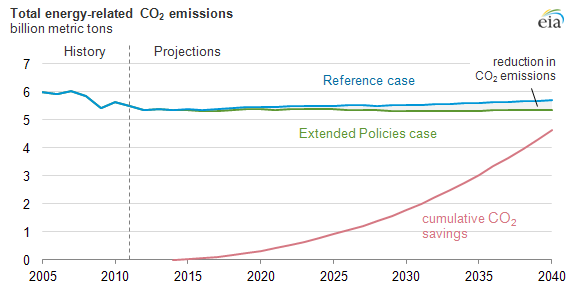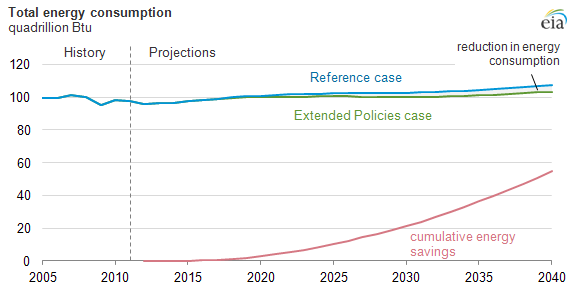
Extending current energy policies would reduce U.S. energy use, carbon dioxide emissions

The Extended Policies case, released today as part of EIA's Annual Energy Outlook 2013 (AEO2013), shows that extending certain federal energy efficiency and renewable energy laws and regulations could reduce annual energy-related carbon dioxide emissions in the United States in 2040 by roughly 6% relative to a Reference case projection that generally assumes current laws and policies. Between 2013 and 2040, this reduction adds up to a cumulative emission savings approaching five billion metric tons.

Projected emissions reductions result from decreased energy consumption as well as additional energy production from low-carbon resources. In 2040, the Extended Policies case projects four quadrillion Btu lower annual U.S. energy consumption than the Reference case. The cumulative amount of energy use is 55 quadrillion Btu lower between 2013 and 2040.
The Extended Policies case differs from the Reference case, which generally reflects policies as they exist in spring 2013, including the assumption that any sunset dates (for example, scheduled expirations for tax credits) or other scheduled milestones occur as specified in law. In the Extended Policies case, EIA explores the possible effects of the indefinite continuation of certain provisions that have expiration dates and the expansion of certain energy laws and regulations.
The Extended Policies case includes key assumptions affecting:
- Electric power
- Residential and commercial buildings
- Transportation
- Industry
The continuation of the production tax credit for wind, biomass, geothermal, and other renewable resources, and the investment tax credit for solar generation technologies exemplify the policy extensions included in this case.
For a discussion of assumptions and results, see the full Issues in Focus article on the No Sunset and Extended Policy cases in AEO2013. The full article also features a discussion of a special case investigating the effects of the American Taxpayer Relief Act of 2012 passed by Congress on January 1, 2013.